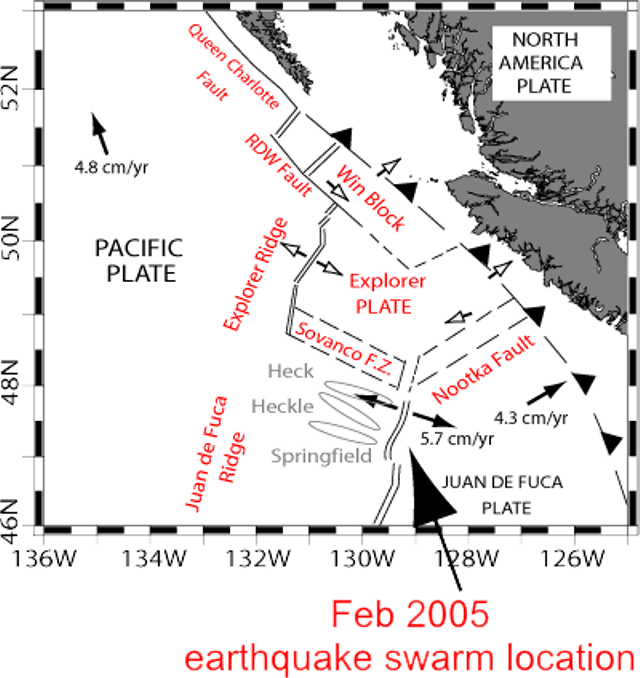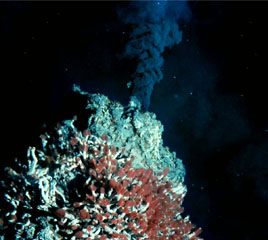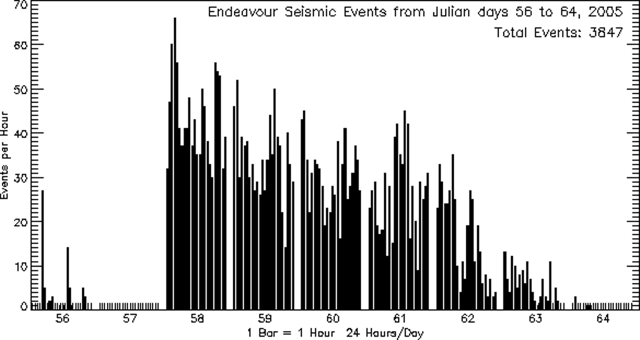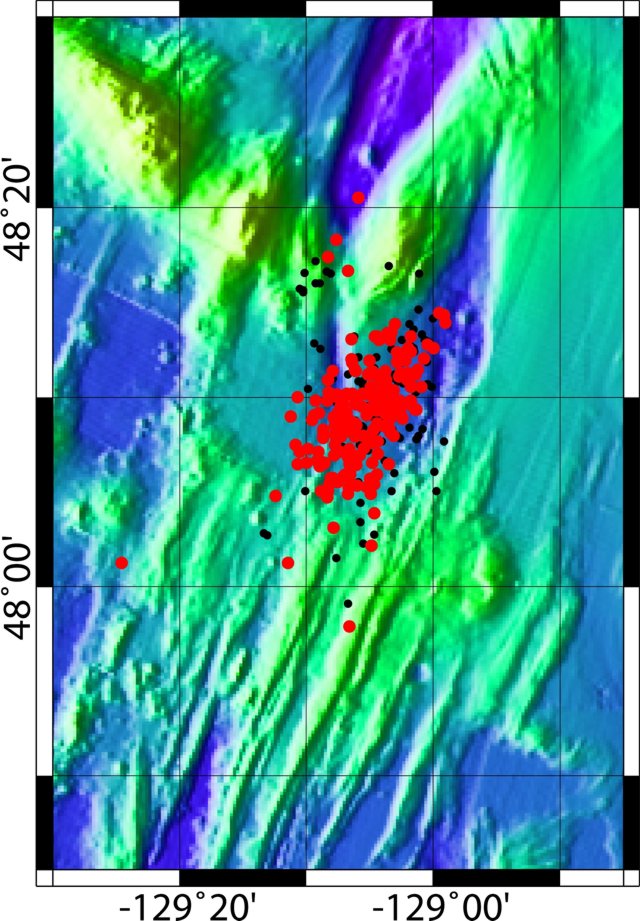Report on Endeavour Segment (Canada) — October 2005
Bulletin of the Global Volcanism Network, vol. 30, no. 10 (October 2005)
Managing Editor: Richard Wunderman.
Endeavour Segment (Canada) Intense earthquake swarm in February-March 2005
Please cite this report as:
Global Volcanism Program, 2005. Report on Endeavour Segment (Canada) (Wunderman, R., ed.). Bulletin of the Global Volcanism Network, 30:10. Smithsonian Institution. https://doi.org/10.5479/si.GVP.BGVN200510-331010
Endeavour Segment
Canada
47.95°N, 129.1°W; summit elev. -2050 m
All times are local (unless otherwise noted)
At 1631 on 26 February 2005 (0031 UTC on 27 February), a hydroacoustic network detected the start of what became an intense earthquake swarm (Ridge 2000 TCS (Time Critical Studies) Oversight Committee, 2005). The source of the swarm was on the Endeavour segment of the northern Juan de Fuca Ridge (JdFR) (figure 1).
 |
Figure 1. Location map of the February 2005 earthquake swarm on the Juan de Fuca ridge along the Endeavour Segment. Courtesy Ridge 2000 TCS Oversight Committee, 2005. |
More than 3,740 earthquakes were detected over a 5.5-day period (figure 2). Event counts were as high as 50-70 per hour, which is similar in scale to event counts associated with sea-floor-spreading events on the ridge at both the Middle Valley segment in September 2001 and at the Endeavour segment in 1999. The hydroacoustic array is the Sound Surveillance System (SOSUS) of the National Oceanic and Atmospheric Administration (NOAA).
The preliminary location of the swarm's epicenters was 48°14.5'N, 128°57.6'W (figure 2), ~ 36 km NNE of the Main Endeavour vent field and a few kilometers E of the intersection of the Heck Seamounts with the JdFR axis. The sequence also produced three large earthquakes (mb 4.5, 4.8, and 4.9) detected by instruments of the National Earthquake Information Center (NEIC), the University of Washington, and the Pacific Northwest Seismograph Network (PNSN). The February-March 2005 seismic swarm also maintained an elevated, nearly constant rate of similar-magnitude earthquakes for several days, behavior consistent with magma intrusion and in contrast to the "mainshock-aftershock" sequence characteristic of tectonic events.
Research response personnel were on station by 6 March, just six days after notification of the seismic swarm, a task that often requires a lead time of over a year. Results from the response cruise indicate that it is unlikely that the February-March 2005 earthquake swarm (figure 3) induced any corresponding expression at the sea floor (i.e., eruption of a lava flow) or in the water column (i.e., formation of new hydrothermal venting, either chronic or event plumes).
In-situ and shipboard physical and chemical data from the three long tow-yo casts and seven vertical casts revealed no water-column signal that can be clearly associated with the recent earthquake swarm, whether magmatic or tectonic. Initial calculations of methane to hydrogen ratios from the Main Endeavour Field, and from Mothra, High Rise, or Salty Dawg vent fields along the Endeavour segment are comparable to historical (2003) values from vent fluids. No evidence of any temperature or optical anomalies was seen in the near-bottom camera tow data (CTD or MAPR) overlying an axial magma chamber reflector, close to the region of the February/March swarm. Camera images of the sea floor revealed no fresh basalt; rather, the entire camera tow track documented lavas with moderate to heavy sediment cover. Finally, no bathymetric anomalies were detected as the cruise scientists searched for evidence of new lava flows in the earthquake area by comparing before and after high-resolution multibeam bathymetry data. The earthquake swarm was thus thought to reflect a magmatic intrusion that failed to generate measurable changes in the sea floor or an intrusive magmatic event that did not reach sufficiently shallow crustal depths to lead to extrusion (eruptive flows) or stimulate venting at new or existing vent fields as discernable via surface-ship sampling.
References. Ridge 2000 TCS (Time Critical Studies) Oversight Committee, 2005, Recent detected events on the Juan de Fuca Ridge, Status report on time critical studies: Ridge 2000 Events, v. 3 (Spring 2005), p. 14-15.
Davis, E.E., and Currie, R.G., 1993, Geophysical observations of the northern Juan de Fuca Ridge system: Lessons in sea-floor spreading: Canadian Journal of Earth Sciences, v. 30 (2), p. 278-300.
Geological Summary. The Endeavour Segment (or Ridge) lies near the northern end of the Juan de Fuca Ridge, W of the coast of Washington and SW of Vancouver Island. The northern end is offset to the east with respect to the West Valley Segment, which extends north to the triple junction with the Sovanco Fracture Zone and the Nootka Fault. The 90-km-long, NNE-SSW-trending segment lies at a depth of more than 2,000 m and is the site of vigorous high-temperature hydrothermal vent systems that were discovered in 1981. Five major vent fields that include sulfide chimneys and black smoker vents are spaced at about 2-km intervals in a 1-km-wide axial valley at the center of the ridge. Preliminary uranium-series dates of Holocene age were obtained on basaltic lava flows, and other younger "zero-age" flows were sampled. Seismic swarms were detected in 1991 and 2005.
Information Contacts: Pacific Marine Environmental Laboratory (PMEL), National Oceanic and Atmospheric Agency (NOAA), 7600 Sand Point Way NE, Building 3, Seattle, WA 98115-6349, and Hatfield Marine Science Center, 2115 SE Oregon State University Drive, Newport, OR 97365 (URL: https://www.pmel.noaa.gov/eoi/); Robert Dziak, NOAA PMEL, Hatfield Marine Science Center, 2115 SE Oregon State University Drive, Newport, OR 97365.



